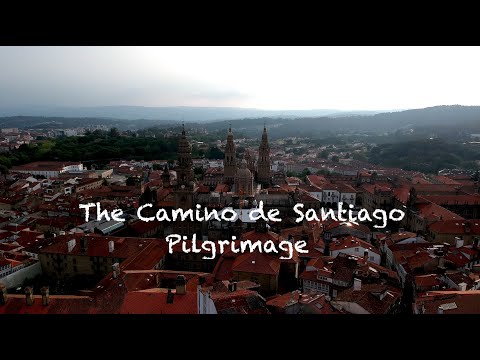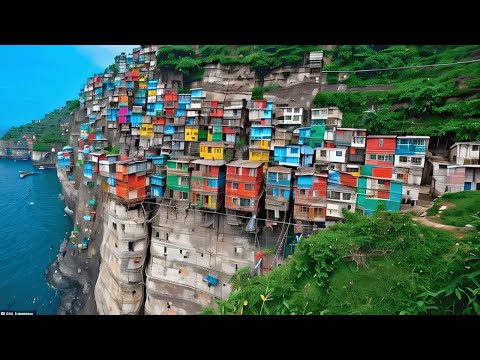Camino de Santiago, The Way of St James. Filmed entirely on the iPhone. Caption available.

The Camino de Santiago or the Way of St James is a pilgrimage of medieval origin stretching across Europe and coming together at the tomb of St James in Santiago de Compostela in north-west Spain. Legend has it, that a hermit named Paio who lived in the old town of Santiago de Compostela saw a bright light above a nearby forest and decide to check it out. There, he found three tombs, later identified as those of the apostle, St James and his two disciples. The discovery took place in the early 9th century and a basilica was built on the site.
A city grew up around the apostle's shrine and would become what is now Santiago de Compostela which means St James of the Field of the Stars. Many follow its routes as a form of spiritual path or retreat for their spiritual growth. It is also popular with hiking and cycling enthusiasts and organised tour groups. The Camino de Santiago has been listed as a UNESCO World Heritage for its important role in encouraging cultural exchanges between people from all over Europe and the world for many centuries. There are many starting points for the Camino de Santiago routes and which one you take depends completely on what you want to get out of the experience.
The reason there are so many different starting points is that the original pilgrims would have commenced their journeys from their own homes. The French Way remains the most famous and popular of the camino route with a distance of 800 km. The Portuguese way is the second most popular route starting at the cathedral in Lisbon for a total of 610 km. The Northern way is less travelled
and starts in the city of Irun on the border with France. It is less popular due to its undulating terrain compared to the French way. The distance is 825 km. The original way is the oldest route, first taken in the 9th century. It begins in Oviedo in northern Spain. The distance is 320 km.
As many of us are working folks from Singapore, we decide to take a much shorter route that begins in Nigran and bring us through Vigo, Redondela, Pontevedra, Caldas de Reis, Padron and finally to Santiago de Compostela. This route is about 150 km and stretches across six days Here are a few things that you need to get started. A good pair of walking shoes, walking sticks and a Camino Passport. Make sure you get your Camino Pilgrim Passport stamped along the way, documenting your progress. It will be proof that you have walked the 100 km necessary to obtain your Camino Compostela or Camino Certificate, the official document testament to your journey. The Compostela is the original religious certificate written in Latin expanded by the church when pilgrims proved they have either walked 100 km or cycle 200 km to Santiago de Compostela.
We fly by plane from Madrid to Vigo and a car brings us from Vigo to our starting point Nigran. Nigran is a city in the province of Galicia with a population of around 18 000 people. The leg from Nigran to Vigo takes us to a very nice and scenic coastal walk along the shores of the Atlantic ocean. At some parts of the walk, we will need to take some pretty steep detours into the suburban residential area.
We come across the famous Samil Beach, the main beach in Vigo which is a stretch of 1.7 km of white sand. It is an extremely lively place with restaurants, cafes, pools and other sporting facilities. One of the symbols that you will see the most along the Camino is the Cruceiros. This stone crucifix is said to protect travellers on their journeys. On the front side, you will see the crucified Christ and on the opposite side you will see an image of the Virgin Mary.
They are religious artefacts that are integrated and embedded in the local culture of the region along the Camino de Santiago As we near the city of Vigo, we come across the Church of Eulalia which was built in 1708. As we move further down, we have an encounter with Vigo's very vibrant urban art scene with a huge mural by Lucas Goce. This is the beautiful city of Vigo with a population of 300,000 people and is the largest and most important fishing ports in all of Europe. The leg from Vigo to Redondela is a very interesting one. The route brings us up a residential highland over-looking the Ria de Vigo.
There is a lot of slopes going up and coming down so i have to say that this stretch is definitely not easy. The Ria de Vigo is an estuary that extends in a northeast direction over a distance of 35 km. It is widest at seven km and narrowest as just 700 m here at the Straits of Rande. Milestones are blocks of concrete or stone that indicate the way to follow to reach Santiago de Compostela. They have the characteristic yellow scallop shell on a blue background and usually located one km apart.
After this stretch of residential highland, the route changes to a forested trail with mini waterfalls sporadically located. The trail gives us a nice vintage view of the Ponte de Rande, a 1.5 km cable-stayed bridge that spans across the Rande Strait. The last part of the leg brings us through a hilly trail, past another Cruceiros, across a countryside trail, pass through a tunnel and finally to the beautiful town of Redondela. Redondela is famed for its two major railway viaducts built in the 19th century.
Due to these infrastructures, Redondela is known as the Village of the Viaducts The leg from Redondela to Pontevedra takes us on a very scenic countryside walk with many interesting encounters. First, we come across a stone shrine dedicated to the Blessed Virgin Mary, followed by a wall full of scallop shells with well wishes written on them. There are many versions on the origin of the Camino Scallop Shell.
My favourite is that a scallop shell is associated with one of the 23 miracles performed by St James. When St James cured a knight who suffered from a throat disease by putting a scallop on the affected area, word spread and people started to use a scallop shell as a healing tool. As we continue, we come across the Ponte Sampaio. This is where the Battle of San Payo was fought in 1809 during the Peninsula War between Spain Portugal and the United Kingdom against the first French Empire. The Spanish forces commanded by Colonel Pablo Morillo defeated the French forces. The battle marked the final evacuation of the French army from Galicia.
We move on and encounter the Capela de Santa Marta, a small roadside chapel which can be easily missed out. It is constructed in 1617 and plays a significant stopover for pilgrims to rest and worship. We pass by a vast grassland with a grazing horse before we arrive at our destination for the day, Pontevedra. Pontevedra is well known for its rich heritage and is only second to Santiago de Compostela in Galicia.
A city of art and history, the city is also known as The Good City, a name attributed by the French author Jean Froissart in his Chronicles in the 14th century. The city is also an important stopover on the Portuguese Way path of the Camino de Santiago. The circular Church of the Pilgrim Virgin has a floor plan in the shape of a scallop shell. The leg from Pontevedra to Caldas de Reis sees us start the day at Parque Natural Ria Barosa. The park is characterised by the presence of the Agra River, whose water drives a series of mills located along its coast. The Agra River also gives form to the Fervent da Barosa, the Barosa Waterfall which reaches a height of 13 m. Together with this cascade, 17 mills are built, both upper and lower mills, forming a hydraulic complex.
We encounter some local fruit vendors and have a taste of delicious cherries along the way. Walking through vineyards can be quite an experience. The church of Santa Maria greets us as we enter the town of Caldas de Reis. Caldas de Reis is known for its hot springs and is the second to last stop on the portuguese way to Santiago de Compostela.
Our 5th leg from Caldas de Reis is a relatively easy one with a somewhat flattish terrain in nice cool weather. Throughout our Camino, one of the common sights is stones being stacked upon each other. Cairns or milladoiros as it is called in Spanish, were placed there by pilgrims to show the route for those following.
Today, many pilgrims leave this camino symbol along the way with a more spiritual significance. Some simply want to say "I was there", others find that a specific spot on the Camino that connects to them and they leave a cairn there for well wishes. As we walk along the countryside trail, we soon encounter some pretty cute and furry sights, dogs peeping out to greet pilgrims! Next, we pass by the historic church of Santa Marina de Carracedo and take a break at the Museo Labrego, an unmanned cafe with vending machines, bathroom and a stone statue of a pilgrim boy. Further down the church, we walked past The Church of San Miguel de Valga, an 18th century church with a large columbarium. As we enter Padron from the south, we will cross the waters of the famous River Ulla over a bridge whose foundations date from Roman times. It was built between the year 25 bc and the first century AD. Padron is a city
that covers an area of 48 square km and just 23 km from Santiago de Compostela. According to tradition, it was Iria Flavia, the old name for Padron that the apostle, St James first preached during his day in Hispania. Soon after his death, his disciples brought his body back here from Jerusalem in a boat. They moored the boat to a pedron which means "big stone" in Galician and hence the name given to this place. This legendary pedron can be seen today at the Church of Santiago de Padron. The parish Church of St James was rebuilt for the first time in the 19th century, although within its thick walls, we can find elements of other churches that were erected before in the 12th and 15th centuries. The highlight of the church is definitely the Pedron. This is where the boat
which transported the remains of St James was moored. The Pedron is located below the main altar. Actually, the Pedron is really a Roman Altar from an undetermined period. Another highlight is the stone pulpit, with the image of St James as a pilgrim, from the 15th century. It belonged to the Gothic church built by Archbishop Lope de Mendoza.
Another thing that is worth mentioning is the most famous produce of Padron, its peppers are usually served fried with olive oil and coarse salt. The main characteristics of these peppers are that you never know if they are sweet or mild or hot and spicy. About 15,000 kg of peppers are grown in Padron each year. Our final leg to Santiago de Compostela got us going at 5am in the morning so that we're able to make it on time for the pilgrim mass at 12 pm. The early walk in the morning before the sun rises is a very refreshing and relaxing one. As the sun rises, we catch sight of the Escravitude Santuary which was built in the 16th century.
Legend has it that a man was doing the Way of St James to cure his heart ailment, stopped there for drink and three days later, was cured. On seeing that he had been healed, the man exclaimed "Thanks Virgin, for releasing me from the slavery of my ailment". Escravitude means slavery in Galician. As we move towards the last stretch of the final leg, we come across another church, The Chapel of St Mary Magdalene in Ames, possibly originating from the 10th century.
It is heartening to see the church full of worshipers attending Sunday Mass. We finally arrive at our destination Santiago de Compostela. Santiago de Compostela is the capital of Galicia and is 220 square km in size with a population of 98,000 people. Tourism is very important, thanks to The Way of St James which attracts more than 280,000 pilgrims yearly. In 1985, the city's old town was designated UNESCO World Heritage Site.
Weighing more than 60 kg and 1.6 m in height the Botafumeiro is one of the largest incense burners in the world. It is also one of the most significant symbols of the Santiago Cathedral. The Botafumeiro is carried and swung by eight men in red robes called tiraboleiros. When in full
swing, the Botafumeiro can reach speeds of up to 68 km/h and it is a sight to behold. For me and I am sure for many pilgrims, this is one of the most touching moments of our pilgrimage. The purpose of the Botafumeiro is to symbolise the true attitude of the believer. In the same way that a smoke from the incense rises to the top of the temple's naves, so must the prayers of the pilgrims rise to reach the heart of God. And in the same manner that aroma of the incense perfumes the entire basilica, so must Christians with the virtues and the testimony of their lives impregnate the society that they live in. The Cathedral is the reputed burial place of St James the Great. It is also one of the three remaining churches in the world built over the tomb of an apostle, the other two being, St Peter's Basilica in Vatican City and St Thomas Cathedral Basilica in India.
The present Cathedral was constructed in 1075 and completed in 1122. The tomb of St James can be found in a crypt beneath the Main Altar. It is here that the remains of St James are kept in a silver urn, alongside those of his disciples St Athanasius and St Theodore. For centuries, pilgrims have visited this holy site - The Cathedral holding the remains of Spain's patron saint. When you enter the Cathedral, right on the high altar is a statue of St James. Behind the statue is a camarin, or small room, accessed by a set of stairs. This is where pilgrims of the Camino climb those stairs, approach the statue and offer their thanks for a safe journey and hug him.
Thank you St James for keeping all of us safe throughout our pilgrimage. Thank you St James for the stories that you have left behind for us in the Camino and the many experiences that we have enjoyed. And thank you St James for showing us the way to be more like Christ
2022-03-31 03:43


